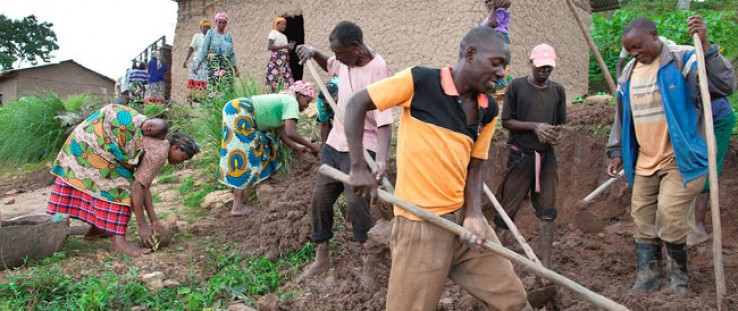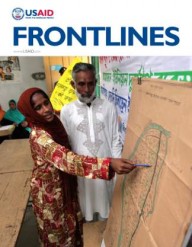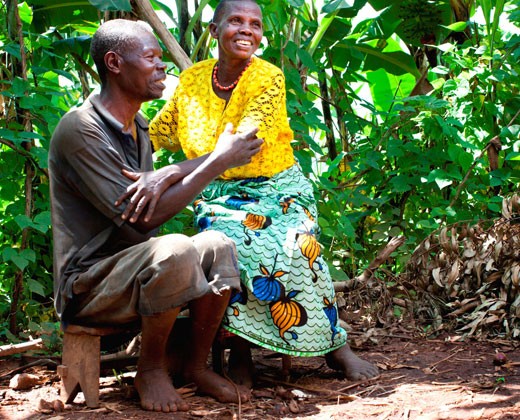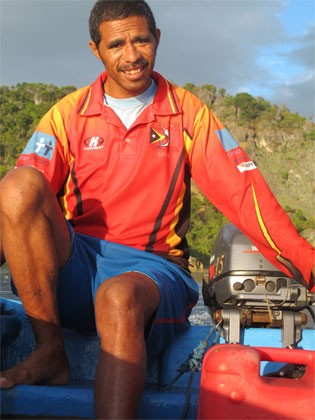 Dialogue club participants work together to rebuild the home compound of one of their fellow club members.
International Alert, Rwanda
Dialogue club participants work together to rebuild the home compound of one of their fellow club members.
International Alert, Rwanda
 Dialogue club participants work together to rebuild the home compound of one of their fellow club members.
International Alert, Rwanda
Dialogue club participants work together to rebuild the home compound of one of their fellow club members.
International Alert, Rwanda
Speeches Shim
In April 1994, Marie Kirezi* was a wife and mother of six in Rwanda’s southern district of Gisagara. An ethnic Hutu, Kirezi was married to a Tutsi man—a common arrangement in the country despite widespread violence and divisions between Rwanda’s Hutu, Tutsi and Twa people.
The genocide started on April 7 that year. Days later, Kirezi witnessed her own brothers attack and murder her husband and six children because they were Tutsi.
“I will never forget the voice of my second eldest son screaming to his maternal uncles to intervene and save them,” Kirezi said. “I tried to kill myself then and many times soon after, but death refused me.”
During the genocide, an estimated 800,000 Rwandan men, women and children were murdered in the span of 100 days. In the 18 years since these atrocities, Rwandans have faced the daunting task of rebuilding their society while addressing the severe trauma and tensions much of the population still experiences.
The circumstances became especially difficult as Rwandans began to return to their former communities from jail, exile or hiding; a situation that often placed genocide survivors in close proximity to those who attacked them and their families. When survivors return to their former communities, they often do so with few assets as well as serious mental and, frequently, physical scars. When Kirezi returned to her community, she not only returned without her family, but also to a looted and badly damaged
home.
Kirezi’s experience was common among survivors, most of whom are
women and orphans. Women, especially, have limited means to earn incomes. They often take in orphaned children, and must overcome
myriad forms of discrimination. Other groups that were disproportionately affected by the genocide were ex-prisoners, ex-combatants and the country’s young.
A Holistic Approach
USAID/Rwanda’s Reconciliation and Reintegration Program, implemented by International Alert, addresses the needs of the survivors, ex-combatants, ex-prisoners and youth by providing access to psychosocial counseling and employment opportunities. The program’s primary goal is to improve livelihoods among these key groups and to foster reconciliation, tolerance and understanding within communities divided by conflict.
USAID helped create community- and school-based discussion groups called Dialogue Clubs for Peace. These clubs provide a space for individuals from all social categories to share and listen in a way that builds common ground and understanding—paving the way to peaceful resolution of future conflict.
“The provision of space for individuals to express their fear, anger, shame and guilt as well as hear honestly from those they feel are their adversaries, is essential to any reconciliation and healing process because it allows even severely divergent groups to stand in the shoes of the other, and also see commonalities. The dialogue clubs create that space for many Rwandans,” said Gloriosa Bazigaga, country manager of International Alert.
Each club is led by a local facilitator trained in conflict management and trauma counseling, and is comprised of approximately 30 people from a mix of the four target groups—survivors, ex-prisoners, ex-combatants and youth. As community leaders, the facilitators are able to manage productive discussions in what are often very tense and fragile situations.
“At the beginning of trauma sessions, some people would scream after hearing other people’s stories, and anger would often come back. But after a series of counseling sessions you would have a sense of difference—accepting oneself is the first step to recovering from trauma,” one club facilitator noted.
Taking that First Step
After returning to her community, Kirezi, now 50, was approached by a facilitator to join the local dialogue club. Kirezi was initially hesitant, especially when she learned that her brothers, those that had so brutally killed her husband and children, had been released from prison and were also club members. She eventually agreed to attend a meeting.
“My first day of joining the peace club was rewarding,” she said. “I had an individual trauma counseling [session] and indeed it was a few days after that I realized I had serious trauma. Hope came back into my life, and I started thinking of rebuilding my future and finding ways to forgive my family members.”
After a few months of trauma counseling and club participation, Kirezi slowly gained confidence, and after months of trauma counseling and painful dialogue, sought reconciliation with her brothers.
“I am now happy and I regained hope because the dialogue club members are like my own
family. I feel reintegrated and loved again, and more importantly, my brothers have asked forgiveness and we’re now together as a family,” Kirezi said.
Healing and a New Roof
Typically, dialogue clubs not only function as places of healing, but also sources of support and assistance. Members of Kirezi’s club helped her build a new house in the community near other survivors.
Like Kirezi, Elaine Mukahirwa returned to her community a widow and with only four of her six children. During the genocide, she escaped her neighbor Alexis Kamanzi’s attack on her family that took the lives of her husband and two children. All told, Mukahirwa lost over 30 members of her family, and returned to her community struggling with loss, fear and isolation.
To make matters more difficult, after confessing his crime, Kamanzi was released from prison and soon arrived back in the community. “I couldn’t bear seeing Alexis walking again in the fields next to my house and to my remaining children,” Mukahirwa said.
Soon after his arrival, Kamanzi sought Mukahirwa out to ask for forgiveness—a gesture of unity that the Rwandan Government encourages former prisoners to make. At the time, the request was much too traumatic for her to bear, and she refused.
Resolute, Kamanzi reached out to the program’s facilitator to help him arrange a time to meet with Mukahirwa in the local dialogue club. Mukahirwa eventually agreed, and after many meetings and counseling sessions, she came to believe the sincerity of Kamanzi’s requests and was moved to forgive him—transforming both their lives.
Mukahirwa now feels more secure in her community, and Kamanzi was able to shed the shame he felt. Together, now as friends, they inspire others to forgiveness and set an example of the peace possible throughout Rwanda.
It is important to note that reconciliation and forgiveness are long and continuous processes, and that no transformations occur overnight. It is through diligent efforts and many difficult, often traumatic, conversations that individuals, and ultimately communities, arrive at a place of healing.
Making an Impact
Since October 2010, the program has trained 64 facilitators, who lead 45 community-based and 17 school-based clubs in eight sectors across the country. Over 60 facilitators have been trained in trauma awareness and counseling through clinically supervised workshops. To date, these efforts have spurred the involvement of nearly 3,000 participants in dialogue clubs and individual or group-trauma counseling.
The Government of Rwanda, through its National Unity and Reconciliation Commission, also has established a variety of programs, including civic education initiatives, training in conflict management and peace-building, establishment and monitoring of laws and policies that promote unity and reconciliation, and conflict mediation. The country even called up traditional Gacacacourts at the community-level to promote national healing and justice (see sidebar).
A JURY OF COUNTRYMEN
To process the overwhelming number of genocide-related cases, the Government of Rwanda reintroduced the Gacaca trial system in January 2001. Based on a traditional model for resolving disputes in Rwanda, the Gacaca system included community members as judges and witnesses, but was sanctioned and legally mandated by the national government, and required every Rwandan to participate in the trials of their community.
Between 2001 and 2012, more than 12,000 Gacaca courts have tried nearly 1.2 million cases. The courts were authorized to sentence guilty individuals to imprisonment, pay reparations to victims, or perform community service, depending on the severity of the crime. Often times, if the suspect confessed and displayed remorse for their crimes, they were given less severe sentences.
The Gacaca system officially closed on June 18, 2012. Remaining and future cases will be tried before ordinary courts.
“Since the genocide, Rwanda has seen its poverty rates decline from 78 percent in 1994 to 45 percent in 2011. The country is reporting significant improvements in its national health, including significant declines in infant and maternal mortality rates and increasing use of contraceptives and family planning services. These gains are remarkable for a post-conflict state like Rwanda, yet the less visible gains achieved through healing and reconciliation efforts are also necessary for the country and its people to truly thrive,” explains Peter Malnak, USAID/Rwanda mission director.
The Road Ahead
Eighteen years after its brutal genocide, Rwanda is focusing squarely on establishing a knowledge-based economy for its future. For that to succeed, Rwandans need to acquire new skills.
The Reconciliation and Reintegration Program is working through local Rwandan organizations to offer training in business and financial management, to raise awareness about entrepreneurship principles, and to provide grants to youth for vocational training in fields from auto mechanics to hairdressing.
Participants put their training to the test by forming solidarity groups to develop business ideas eligible for micro-credit loans. To date, about 1,300 people are part of the project’s economic development activities. Though not readily evident, the connection between economic development and post-conflict reconciliation is essential.
“Reconciliation can hardly survive and thrive in poverty-stricken societies. Such goals can be achieved when people have developed a sense of business,” says Delphin Ngamije, managing director of one of International Alert’s local partner organizations.
“When survivors and genocide-released prisoners, former warring parties, sit together to discuss their economic concerns and needs, identify common strategies for mitigating risks, maximizing interests for collective prosperity, reconciliation opportunities are created. It starts with discussing about life through a business-oriented framework; gradually concerned parties start approaching such deep social issues.”
Through these initiatives, participants will be equipped to start their own businesses or join the work of organizations throughout the country. Measures like these contribute to USAID’s goals to empower individuals to direct their own paths and to create a more sustainable future for Rwanda.
“In Rwanda, this two-pronged approach to reconciliation and reintegration recognizes that social and mental well-being is inextricably connected to economic well-being,” says Malnak. “In many ways, we have seen the transformative effect of this approach for individuals, through stories of incredible forgiveness and economic opportunity restored—and I believe that in the coming years we will see the program’s sustained impact in the continued progress of participants and the creation of more peaceful communities as their wisdom and experience is shared.”
*Names of some individuals quoted in this article have been changed to protect their privacy.





Comment
Make a general inquiry or suggest an improvement.